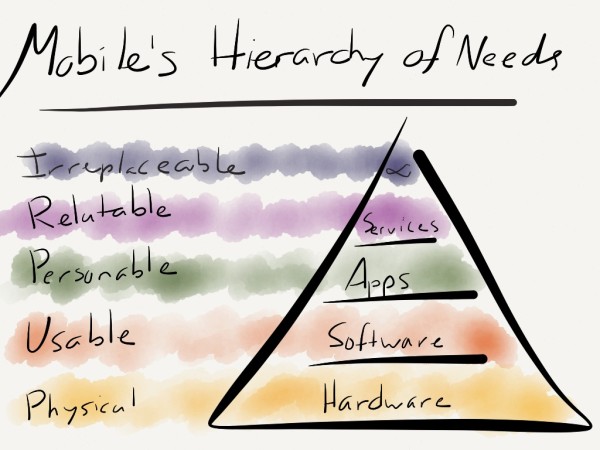The Dropbox Opportunity
The Dropbox Opportunity
Benedict Evans, in Glass, Home and solipsism , one of the most insightful posts I’ve read in some time:
Your customers’ relationships with you are the only relationships you have as a business and you think a lot about them. But you’re one of a thousand things your customer thinks about in a week, and one of dozens of businesses. And they probably have their own ideas about how they want to engage with you (though they wouldn’t put it in those words) – assuming they think about you at all.
This applies even to Google or Facebook (which brings me to the title of this post). There’s lots of data showing the high proportion of online time that people spend using Facebook, and the high volume of web searches that they do using Google. Facebook and Google are important. But that doesn’t mean they’re everything.
It applies to Apple too, and there’s no better example than iCloud versus Dropbox.
Steve Jobs famously called Dropbox “a feature, not a product.” And, if you look at the Mobile Hierarchy of Needs , he was right; Dropbox sits firmly in “Services,” one piece of the overall device value stack.

But devices – even Apple ones – are ultimately a means to an end. For my mother, her iPad lets her see pictures of the grandchildren; for my wife, her PC was a lifeline to Taiwan for four years; for me, my phone keeps me connected and engaged in technology, regardless of time or place.
It’s the ends that are meaningful and infinitely valuable, and Dropbox’s approach to my most important data 1 is much more in line with the value I ascribe to that data: it’s available everywhere.
Not so for iCloud: data is available only on Apple devices, and it’s not exactly clear how to get it out. iCloud is beneficial to Apple’s business model – more devices – yet actively hostile to my needs, in much the same way Facebook Home ignored how people actually use smartphones.
The problem for iCloud, and by extension Apple, is that services – driven by the need for data to be everywhere – are a horizontal layer, orthogonal to the the vertical nature of devices.

The only coherent strategy for Apple is a walled-garden of sorts that protects their vertical business model. A services-centric company like Dropbox, on the other hand, ought to pursue a horizontal strategy predicated on maximizing the number of interconnects with the layers above and below; clients on every platform address the latter, and yesterday’s announcement of the Dropbox Platform are focused on the former.
From Wired :
Today, at Dropbox’s first-ever developers conference, the company is officially launching a new set of coding tools designed to push Dropbox into every corner of your digital life. Not content to stay sequestered inside the box, the company’s co-founders are unveiling ways for developers to meld their service with every app on every device you own…
Dropbox may be in a unique position to do just that. For now, the company has no overarching obligations to Apple, Google, Facebook, or Microsoft. While pundits have recommended that some big tech company ought to snap up Dropbox while it’s still relatively affordable, Dropbox is in a position where it can layer itself over competing operating systems while being beholden to none. Says Houston: “No engineer in Cupertino is thinking: ‘How do I make this work with Android?’” Leave that thinking to Dropbox…
Taken together, she says Datastores and Drop-ins transform Dropbox into a platform that enables a “pervasive data layer” — a way for all your digital stuff to follow you everywhere, regardless of device, operating system, or app.
The strategy is spot-on; while iOS and Android (and mostly Samsung) have effectively won the battle for devices, the winner in horizontal services will certainly not be Apple.
The contenders in the consumer market: 2
- Google has pole position. Android was a detour to ensure the services layer was competitive, and now Google is fully focused on winning. However, Google is not as developer friendly, and the way they view data as a commodity can result in user-hostile choices. Moreover, there is always the potential of Google favoring Android, although I think the removal of Andy Rubin was about making sure this doesn’t happen
- Microsoft has more strengths here than most people realize. Skydrive is one of the best products they make, and Azure cloud services already provide most of what Dropbox is rolling out. The challenge for Microsoft is perception and mindshare amongst developers especially. Moreover, Microsoft’s strategy of devices and services is about competing both vertically (devices) and hoizontally (services). This is a great recipe for strategy taxes
- Amazon has pieces, particularly cloud storage, and they are clearly willing to compete on price. However, to say that Amazon struggles with great user interfaces is putting it kindly, and I don’t see any real evidence they are interested in anything they can’t sell
- Yahoo! has massive reach, and some intriguing pieces, including Mail, Flickr, and now Tumblr. However, they are pursuing the Google signal-to-ads monetization model , and haven’t been relevant to developers in…ever? Yahoo should have bought Dropbox
- Dropbox has a great base product, a monetization model that is aligned with the value customers place on their data, and excellent mindshare amongst app developers especially. However, Dropbox has a much more limited reach, and I’ve seen precious little evidence they have the marketing chops to overcome that
There likely won’t be one clear-cut winner, as the individualized nature of data works against the network effects that would lead to winner-take-all. That said, Dropbox’s developer mindshare is a massive asset in this regard, especially if Dropbox is able to marshall developers as Dropbox advocates.
Regardless, that set of contenders is good company and gives a hint as to why Dropbox’s valuation is so high.
文章版权归原作者所有。
